Cost Analysis: Is Micro Cement Cost-Effective for Your Project?
Micro cement is renowned not only for its sleek and modern finish but also for its versatility in application across a variety of surfaces. For property owners and developers considering new construction or renovation projects, understanding the cost implications of choosing micro cement over traditional materials is crucial. This cost analysis aims to break down the expenses and long-term benefits of micro cement to help you make informed, budget-conscious decisions.
Initial Cost vs. Long-Term Savings
1. Initial Investment: The initial cost of micro cement can be higher than traditional materials like conventional concrete or ceramic tiles. This is due to the specialized nature of the materials and the skilled labor required for application. Micro cement requires a precise mix and careful application to achieve its signature seamless finish, which often means higher labor costs.
2. Long-Term Durability: Although the upfront cost is higher, micro cement is extremely durable and wear-resistant, which translates to lower maintenance costs over time. Unlike tiles that may crack or wooden floors that need refinishing, micro cement maintains its condition for years. This durability reduces the need for costly repairs and replacements, providing significant savings in the long run.
3. Versatility and Aesthetics: Micro cement's ability to adhere to almost any surface reduces the need for material removal or surface preparation. This can lower project costs by eliminating steps in the renovation process, such as the removal of old tiles. Additionally, its aesthetic appeal and the ability to customize its color and texture can increase property values, offering potential financial gains if the property is sold in the future.
Comparative Analysis with Other Materials
4. Cost Comparison with Tiles: Installing tiles involves costs for the tiles themselves, preparation of the underlayment, and labor for laying the tiles. Micro cement, on the other hand, can be applied directly over existing surfaces, saving on both materials and labor. While tiles can crack and require grouting maintenance, micro cement does not have joints or gaps, eliminating these additional upkeep needs.
5. Cost Comparison with Hardwood Flooring: Hardwood flooring installation is costly, and maintaining it can be expensive due to susceptibility to water damage and the need for periodic sanding and refinishing. Micro cement offers a similar warm aesthetic without the high maintenance costs, making it a cost-effective alternative for areas with high foot traffic or exposure to moisture.
6. Energy Efficiency: Micro cement's excellent thermal mass helps in regulating indoor temperatures, reducing reliance on heating and cooling systems. This energy efficiency can lead to significant savings in utility bills, adding to its cost-effectiveness.
While the initial cost of micro cement might be higher compared to some traditional materials, its long-term benefits - durability, low maintenance, aesthetic flexibility, and energy efficiency - often justify the investment. For those looking to invest in a modern, long-lasting, and efficient finishing material, micro cement is an increasingly popular choice.
At 2nd City Spray Solutions, we provide comprehensive micro cement solutions tailored to your specific needs and budget considerations. Contact us to discuss how micro cement can be cost-effective for your project and to get a detailed quote.






